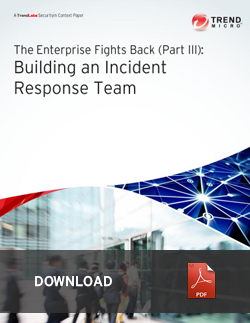Are Incident Response Teams Really Necessary?
January 31, 2014
 View primer: Building an Incident Response Team
View primer: Building an Incident Response Team
Enterprises can, however, prevent threat actors from penetrating their networks and consequently stealing confidential data or their “crown jewels” by using robust security technologies and implementing security-related procedures.
A study indicated that the majority of enterprises consider securing data one of their top challenges.Targeted attacks, which are high-risk threats, aim to exfiltrate and transfer stolen data to an undisclosed location that threat actors manage. They remain undetected in target networks for a long period of time and laterally move within in order to gain access to valuable enterprise data such as intellectual property rights, trade secrets, and customer data.
To stay protected, enterprises must assume they have been compromised even before their IT administrators detect any malicious activity within their networks.
View the third part of The Enterprise Fights Back series of primers: Building an Incident Response Team
HIDE
Like it? Add this infographic to your site:
1. Click on the box below. 2. Press Ctrl+A to select all. 3. Press Ctrl+C to copy. 4. Paste the code into your page (Ctrl+V).
Image will appear the same size as you see above.
 Cellular IoT Vulnerabilities: Another Door to Cellular Networks
Cellular IoT Vulnerabilities: Another Door to Cellular Networks AI in the Crosshairs: Understanding and Detecting Attacks on AWS AI Services with Trend Vision One™
AI in the Crosshairs: Understanding and Detecting Attacks on AWS AI Services with Trend Vision One™ Trend 2025 Cyber Risk Report
Trend 2025 Cyber Risk Report CES 2025: A Comprehensive Look at AI Digital Assistants and Their Security Risks
CES 2025: A Comprehensive Look at AI Digital Assistants and Their Security Risks